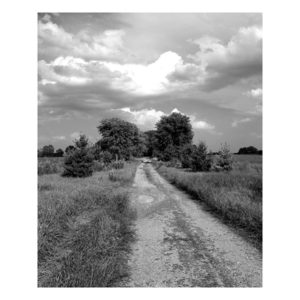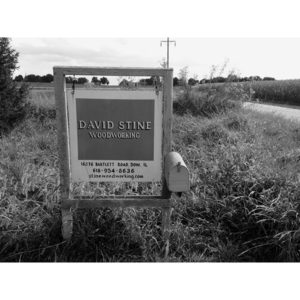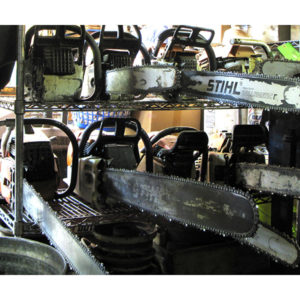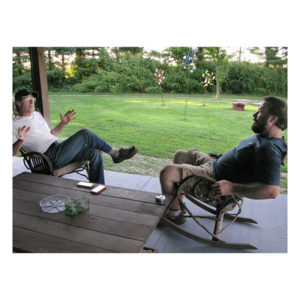
It’s hard not to like a guy whose eyes well up when he talks about pushing his spirit into his tools, but who also gives a very man cave thumbs up when discussing his beer fridge. David Stine is a man well expressed through his furniture. They’re both held together by the tension of opposites: burly and lithe, lush and minimalist, rural and sophisticated. His whole slabs with live edges leave you in awe of the tree that was.
I’m on assignment from my son (and new business partner) Tor, to sit down and talk with Dave about woodworking. At 42, Dave is closer to Tor’s age. He started Stine Woodworking in 1995, after a very brief stint as a trust and estates attorney.

Dave lives and works on a fine swath of land in southwestern Illinois, near Missouri, just north of where Lewis and Clark set out on their trek in 1804 and where I’m en route to an art fair. Not that those two journeys are entirely comparable, but it is quite a haul to Stine HQ. Seen from a satellite, the acreage is a tiny island amid vast fertile valleys full of corn. Dave is the fourth generation to steward this land. His son will be the fifth. We share Midwestern roots, Dave and I, along with a love for our craft and the place we practice it and the sense of continuity that both provide.
I visit Dave on a warm, windows-down September afternoon. His driveway reveals a pastoral paradise; here wild, there landscaped, everywhere dappled light. When I finally arrive at his shop, Dave says he’s been tidying for my visit. I might go ahead and file that under “stories”. Dave Stine has many. He is, as they say, bigger than life. Settle in with us, in rockers made by Dave, on the porch just past the smoking Hardy furnace that heats his house, water, and wood kiln. Dave’s going to tell me why a perfectly good lawyer left it all behind to pursue his passion for woodworking in a particleboard age.
Bob: I feel a little awkward about just sitting down for 45 minutes and running a tape recorder in front us.
Dave: All right. You know what? You run yours and I’ll run mine at the same time.
Bob: Well, one of Tor’s questions was, ‘How did growing up in the Midwest…’
Dave: Oh, that’s a good one.
Bob: People from Iowa say there are two kinds of people in the world, those who work and those who don’t.
Dave: There’s a certain work ethic that goes along with growing up in the Midwest. In my booth, people will say, ‘Where are you from?’ and I will say, ‘I’m from the Midwest where all good stuff comes from.’ Everybody’s heard all about New York and California, but good stuff is coming from the Midwest. You know, design wise…
Bob: Red Wing boots.

Dave: Yeah, there you go. Red Wing boots is a great example, you know?
We just shot a commercial down here. This company found me on the internet and they wanted to use my shop as a backdrop for this Midwestern company that does financial advising up in Chicago. They came down here and spent two days and shot this huge video here in the workshop because they wanted to kind of get that imprimatur of Midwestern values and work ethic and we pay attention to details just like this woodworker guy.
Bob: I see, I see.
Dave: I am actually interested in what we were talking about before. How did you get interested in this kind of work? Because I know you said something about being overseas and getting some experience over there.
Bob: Well, it was the 60s. I just finished college, wrapping up four years at the University of Nebraska and…
Dave: Did you have a low number or a high number?
Bob: It was before that.
Dave: It was before the draft?
Bob: The draft was in full bore–but it was before the lottery. I took a summer school class at San Francisco State and I saw a guy who was doing some woodworking and I read one of those Foxfire books.
Dave: Oh yeah? Did you see them out in the shop? I have all of them.
Bob: You do?
Dave: They’re great.
Bob: It turned out there was the story of Charlie the Chair Maker in one of these, maybe you don’t even remember it.
Dave: It’s ringing a bell for sure.
Bob: Anyway, there was a guy who did post and rung, busting chairs from trees. I later met Wendell Berry and I learned he had been very influential in giving this guy some publicity.
Dave: Was he like an Appalachian guy?
Bob: Yeah, he was Appalachian, yeah. And then this guy in Berkeley had gone to Alaska or Canada and built a log cabin. The materials looked so rich and I was just pulled in. I had never done any woodworking before. Then I started looking for somebody to learn something from. I was in Nebraska and I didn’t find anybody. I went to Denver. In Denver, a guy by the name of Lily, who did rustic stained ski lodge type furniture–real thick slab stuff, he said, “Well, I don’t need anybody. Maybe there is more opportunity in California”. So, I ended up out in San Francisco at Art Carpenter’s shop. Art introduced me to Ed Stiles and I spent a year working with him.
Dave: Wow! That must have been a good start.
Bob: A lot of people went through Art Carpenter’s studio in those days. I was just one of many. So, that was my start. What about you?
Dave: Well, I grew up on a dairy farm right over here and we’d always done everything ourselves, from building our own houses to building our own barns, fencing, all that kind of stuff. Logging in the winter times and get a little bit of lumber together just to slap stuff together. I mean, no real fine work ever.
When I was growing up and even today, we’d just do everything right there on the farm. We still butcher our own meat, my mom makes sauerkraut, we have a big garden and we’re canning stuff all summer. It was always just about self-sufficiency.
And it was a dairy farm when I was growing up, so there was milking every morning and every evening. If milking teaches you nothing else, it teaches you that you don’t want to do that for the rest of your life. Logging and building furniture and the hard work I do now seems like a cakewalk compared to the lives my grandparents and my uncles lived. I mean, those guys are just, I don’t know. They’re incredible workers and it’s every day, twice a day, no matter what. End of sentence. There is no holiday.

Bob: But Dave, seeing your place here, there is a sophistication and kind of an urban interface with your life somehow that came along. You, obviously, have done some other things besides milking cows.
Dave: That’s true. This place has been in our family…my son’s generation would be the fifth, so I’m the fourth generation. My grandfather, when he went into World War II, they trained him in avionics and he went all over the world. It was my grandfather I was probably the closest to and who had the biggest influence on me and my whole life. He lived in Okinawa, he lived in Alaska, they lived in California, they lived on the East Coast in big cities, doing avionics.
So, although the farm has always been the real touchstone for the whole family, they’re not just country, home-spun people. They’ve been around, they understand culture, they understand the value of a good education. So, they always pushed me and the rest of my eight cousins towards experiencing the world, going out and living, not just being insular and staying here in our own little bubble.
We always did stuff on the farm. We always cut lumber, had lumber sawed up. I would love it when the boards would come off the mill and there would be the live edge and those great shapes, and I think that, you know, probably back when I was 10, 12, 13, 14, when I first started seeing those kind of possibilities in the wood, before I ever heard of Nakashima or Maloof or any of these guys, I just took it up as a hobby. We still had vocational education in high schools and stuff. So, I could take woodshop and actually get…
Bob: In this area?
Dave: Yeah, right around here. I am the oldest in my generation. My grandfather hammered away at me. He was always like, “It is up to you, you have to sort of keep the family farm together, the taxation, all that kind of stuff. You need to figure out how to do the trust and probate planning.” So, after college… I went to college at Penn State and did a little bit of woodworking. My dad had a little bit of woodshop, his house is out there. And then after that, I went to law school at George Washington in D.C, just focused on trusts and estates, wills, probate and tax planning so that I could help out my family and, sort of carry on what my grandfather always wanted me to do.
Bob: Very goal-oriented.
Dave: Yeah, you know, it was a real goal. But, I also loved school. School is way better than working, as you know. So, it was great. I always had a little woodshop there, but I ended up with the guy who would become my future brother-in-law. We got a little space together and he did screen printing.
I started building humidors, during that big humidor craze, back in the early 90’s. So, yeah, everybody was into cigars and I sort of built humidors, just while I was in law school and all of a sudden I had, you know, these crazy orders for these custom humidors that I just couldn’t fill part time, but I just kind of let that go when I started practicing law. I practiced for about a year, and I probably had a year’s worth of orders, not just humidors at that point. I was doing contract furniture work, doing work for designers, building their designs and then building some of my own stuff too. And that’s really what was the jumping-off point for me. So…
Bob: I remember the first time doing chain milling, you know, just seeing that slab come off and thinking, my god if this was out in the forest and you came upon it, what a piece of sculpture!
Dave: Milling lumber is one of the best things ever about this work and I get so much inspiration from it. I don’t know if I would… I would have probably never gravitated to this if that wasn’t a viable component of my business. It’s still one of my favorite things. I mean, everybody has been everywhere in this whole world, they have seen it all, but when you cut into that log, you are the first guy that’s ever seen that, every time. And every time, it’s surprising and beautiful and just cooler the next time.
Bob: It’s true. I sort of refer to this as, it may not make economic sense, but, you know, it’s kind of the religion of woodworking.
Dave: The religion of woodworking?
Bob: I think that’s how I try and explain it to myself.
Dave: I know what you mean because we wouldn’t do this–you and I–we are smart guys, right? If we were just looking to make money, this would not be what we would be doing, right? I would have stayed as an attorney or done something else and you would have maybe done something else as well. But you love the material, you are inspired by the wood itself, you are inspired by the work. You have to have that as the driver in order to keep doing what we do for the money that we do and for the uncertainty that we do.
I mean, you’re going to a show this weekend, it could rain cats and dogs and you might have just spent $5,000 and five days of your life for no return whatsoever, you know? And that’s every weekend. And that’s every weekend for the rest of our lives. There are no guarantees. I buy stuff with–like when I bought my van, when I buy tools–I pay for them because I don’t know if next week I have any orders. And I don’t buy until I have the money in the bank. I don’t loan anything because I just don’t know if I will have any money.
Bob: I think that’s a Midwestern thing.
Dave: Yeah, well that might be too.
